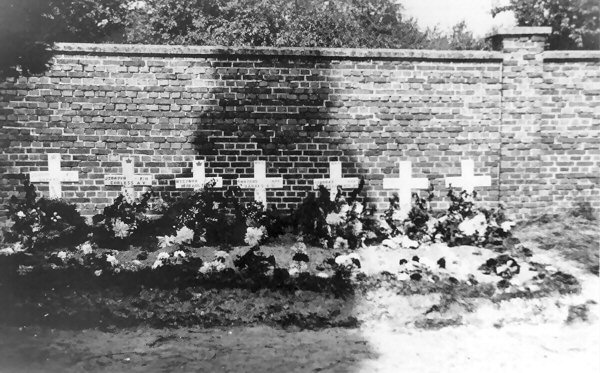207 SQUADRON ROYAL AIR FORCE HISTORY
The loss of LANCASTER ME 683 EM-W: 207
Squadron, RAF Spilsby 1944
Meeuwen-Gruitrode, Belgium 21/22 June 1944: The Aftermath
On the night of Wednesday, 21/22 June Lancaster ME683 EM-W captained by Flying Officer Alvin Corless RCAF lifted from RAF Spilsby, its Lincolnshire base. After gaining height with twenty-one other aircraft from the squadron ME683 joined the main bomber stream, which consisted of fifteen Mosquitoes, mostly acting as pathfinders, and 156 Lancasters, the majority of which were from No 5 Group. The targets were the synthetic oil plant at Wesseling to the south of Cologne, and the Scholven refineries at Buer near Duisburg in the Rhur Valley.
The German night fighters were scrambled in good time and soon found their way into the main bomber stream, where their task was made easier than usual by a blanket of low cloud against which the bombers were silhouetted. Of the force bombing Wesseling 37 Lancasters were lost - more than a quarter of those who had set out, five of which were from 207 Squadron.
At approximately, 0130hrs, south west of the village of Meeuwen, Flying Officer Corless and his crew became involved in an air combat with Major Heinz Wolfgang Schnaufer of Geschwader NJG4 based at St Trond.
WITNESS REPORTS
The priest of Meeuwen
The incident was witnessed by the priest of Meeuwen, the Reverend Father Jozef Vranken, who saw a burning four engined English aircraft pass over the church, although this was more than likely a little further north. The stricken Lancaster jettisoned part of the bomb load above the woods between Ellikom and the area of the present industrial park at Meeuwen, before arcing south of the town and exploding in the air above open country side.
The explosion must have occurred at a low altitude as the debris from the wreckage was scattered, in close proximity, in a meadow behind the house of Jozef Coaers-Paesen, on the spot called 'Genits het gehucht', which is one kilometre from the village centre.
The bodies of six of the aircrew were found near the wreckage and these were taken to a place of rest. Initially, it was thought that all the crew were Canadians. On the morning of Saturday June 24, 1944 the village policeman, Jozef Geers, instructed three workmen, one being the gravedigger, Arnold Winters-Schepers, to dig a communal grave. The six crew members were buried together at 1600h in the north west comer of the cemetery. The grave was blessed and a De Profundis was said for the Catholic airmen. This sad event proceeded in the presence of the Mayor, the Secretary and the village policeman of Meeuwen.
On the evening of July 3 a seventh body, the rear gunner, Sgt James Magoffin RCAF, was discovered in a cornfield belonging to Mathijs Paesen. The money, photographs and other objects found on the body were handed over to the local Commander of the German Dienstelle der Feldpostnummer. The body of James Magoffin was taken by cart and laid in a coffin and on July 5 he was buried alongside his comrades.
Fourteen year old Jozef Paesen
The events relating to Lancaster ME683 were witnessed from his bedroom by fourteen year old Jozef Paesen whose house was closest to the crash site, Here is his recollection of that time: "Hubert Hilven aka Beer van Hem van'e Sjriejer, who was still living with his parents, came to call on us. Small parts of the aircraft had come down on our roof, but the damage was only a few broken roof tiles."
"When the aircraft crashed several bombs exploded on land belonging to our farm. Somewhere there was also a giant bomb of about 2000kg (4000lb Cookie blast bomb) a colossus as big as a manure barrel. Though it had cracked, it didn't explode. Immediately the Germans appeared to guard the site where the main pieces of wreckage lay."
"The wreck of the Lancaster remained there for three or four weeks. During that period two German soldiers stayed with us (Geejtjes) and another two stayed with our neighbour (Heitemis). Those soldiers stayed on the Genits to help tidy up the wreck of the bomber. The pieces were carried off on lorries. The two Germans staying with us listened to the English radio. They were married men of 50 to 65 years of age whose sons were fighting on the Eastern Front."
"Those Germans had to dismantle the crashed Lancaster. While they were doing so, we could not get close to the wreck. Yet the pinching didn't stop. Some friends who went to the technical school managed to sneak small pieces they could hide in their pockets. All around the site of the crashed bomber the Germans had put 'No admittance' notices with the words 'Achtung! Bomben!' "
"There were also bullets everywhere. We found many of them. My brother Louis hurt his leg by hitting the cap of a bullet (cartridge) with a very sharp object in order to set it off. He and his friend Martinus Kerkofs aka Teng van'n went to Doctor Vandeven at Bree to have the wound treated. My parents never knew about it. Louis paid the doctor with the money he had made by breeding and selling rabbits."
"The Hilvens aka van Sjriejer had found a big box (the dinghy from the starboard wing housing) in which there was a smaller box. We had taken the latter home and tried to hide it secretly in our bedroom under my pillow. Suddenly, the thing started hissing and spreading an awful smell. We got scared and threw it out of the bedroom window. (This was probably a box of flares).
The seven graves in the cemetery at Meeuwen received headstones from the Canadian agency of The Commonwealth War Graves Commission. As long as the crew rested at Meeuwen the Council were allotted an annual allowance to maintain the graves.
On the right column of the gateway to the cemetery there was a small green tablet telling people, in white letters, that part of the cemetery of Meeuwen was a Commonwealth War Graves Commission cemetery.
In the early 1980s, and due to the town's expansion the town cemetery was relocated to a new site on the outskirts of Meeuwen. It was at this time that the seven crew members were exhumed and moved to the Canadian military cemetery at Adegem, West-Flanders, where they now rest.
source: J Bosmans
|
FROM FAMILY ALBUMS
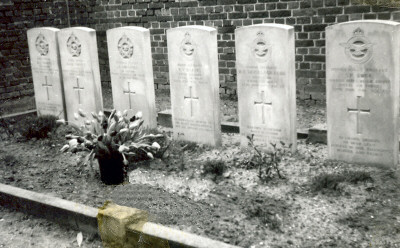
Headstones at Meeuwen 1958: L-R Somers - Corless - Mireault -
Barnes - De Casagrande - Bore: source Christie
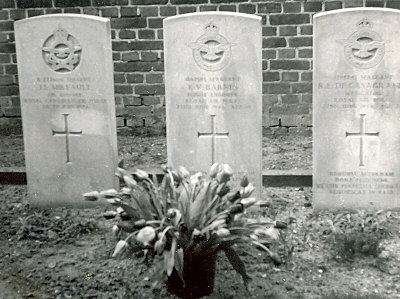
Headstones at Meeuwen 1958: L-R Mireault - Barnes - De
Casagrande - Bore: source Christie
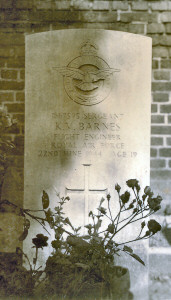
Headstone of Sgt Ken Barnes
Meeuwen, 1958: source Christie
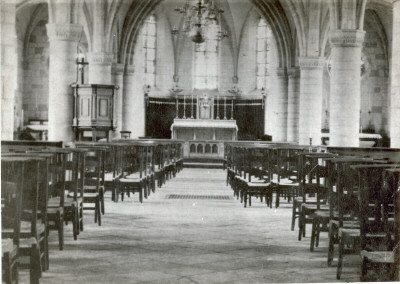
A view of the church at Meeuwen, 1950s: source Christie
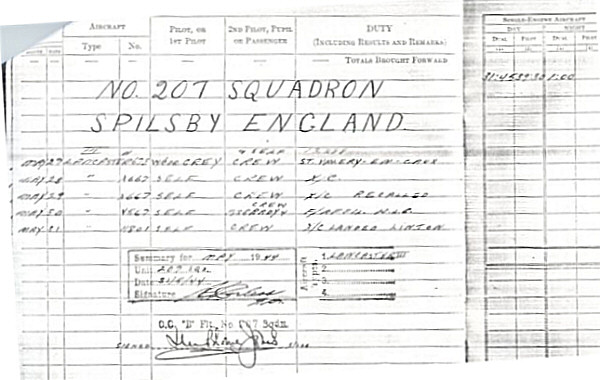
Alvin Corless' logbook, countersigned by Sqn Ldr
Blome-Jones, OC B Flt
Note that the May 31 1944 entry is a cross country, landed
Linton - where the present day 207 Sqn is based
source: Wally Fydenchuk
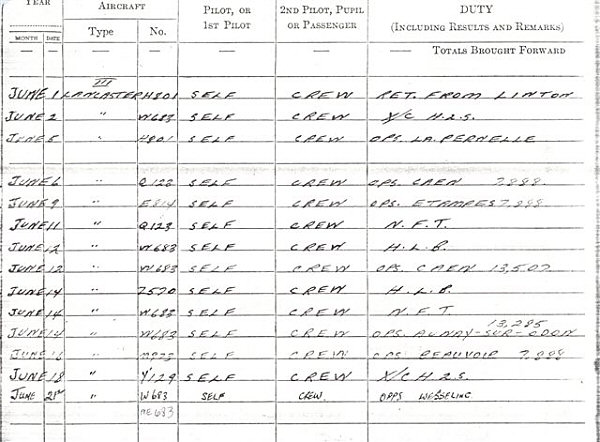
Alvin Corless' logbook, showing the final entry in
another hand 'Opps Wesseling'
source: Wally Fydenchuk
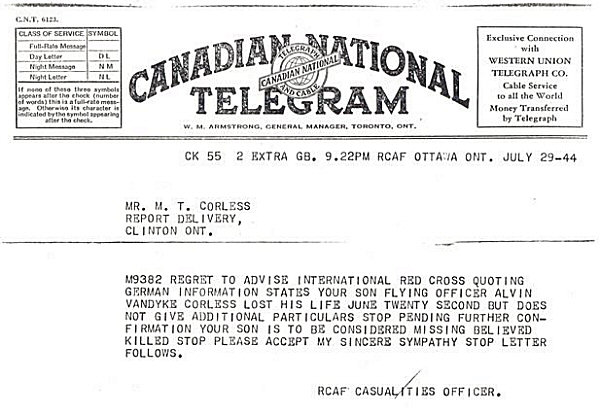
source: Wally Fydenchuk
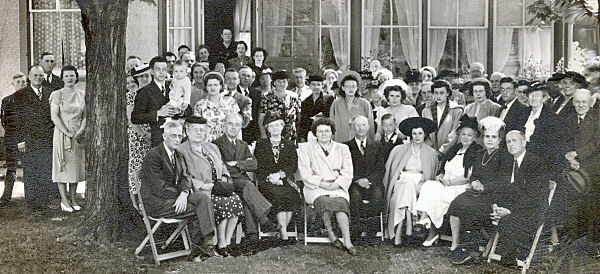
The Corless family and friends at the time of the dedication
of a window
to Alvin Corless Wesley-Willis United Church in Ontario, date unknown
Please contact the editor if you can provide more
information.
source: Christie
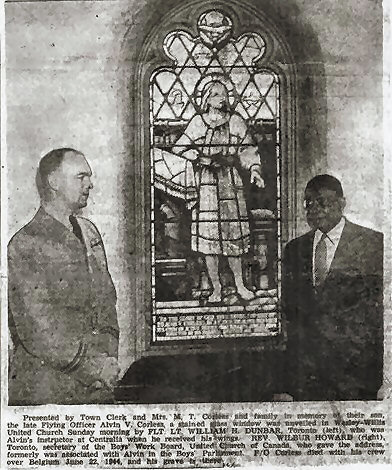 |
caption: Presented by Town Clerk and Mrs
MT Corless and family in memory of their son, the
late Flying Officer Alvin V Corless, a stained glass
window was unveiled in Wesley-Willis United Church
Sunday morning by FLT LT WILLIAM H DUNBAR, Toronto
(left), who was Alvin's instructor at Centralia when
he received his wings. REV WILBUR HOWARD (right),
Toronto, secretary of the Boys' Work Board, United
Church of Canada, who gave the address, formerly was
associated with Alvin in the Boys' Parliament. F/O
Corless died with his crew over Belgium June 22,
1944, and his grave is there. source: Wally Fydenchuk |
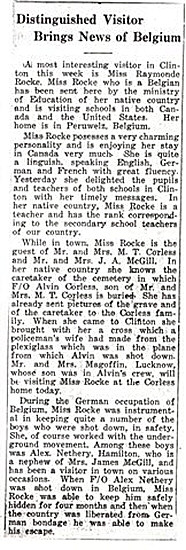 undated article: via Wally Fydenchuk, Canada, Jan 2006 |
DISTINGUISHED
VISITOR
|
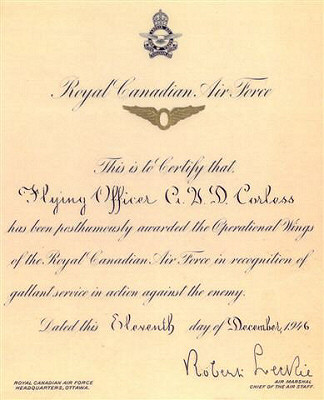
via Wally Fydenchuk
The sister of Sgt Kenneth Barnes
Mrs Sheila Christie, sister of Sgt Kenneth Barnes writes in August 2005 "In 1945 my parents took my brother and me to Belgium for two weeks. For two weekends we stayed at the Hotel Union in Bree so that we could go to Meeuwen to the graves.
The Burgermeister made us very welcome, taking us across the fields and woods where the plane had come down. We saw the wing of the plane on the barn of the farm house. They were hoping to get the boys to safety but it was not so! They also said that the Germans put the six boys against the haystack and that a young boy of fourteen tried to get Ken's parachute and was shot, but that does not seem now to be true.
Then in 1954 I went again, also in 1958 when the headstones had been put on. They told us that a mass was said every year in June for the boys, which I thought was lovely."
Her brother Ken's ambition was to work for an American airline after the war. Before volunteering for aircrew he had worked as a fitter on aircraft at Broxbourne Aerodrome and then on the engine test-beds at De Haviland's at Hatfield.
updated 22 Jan 2006
